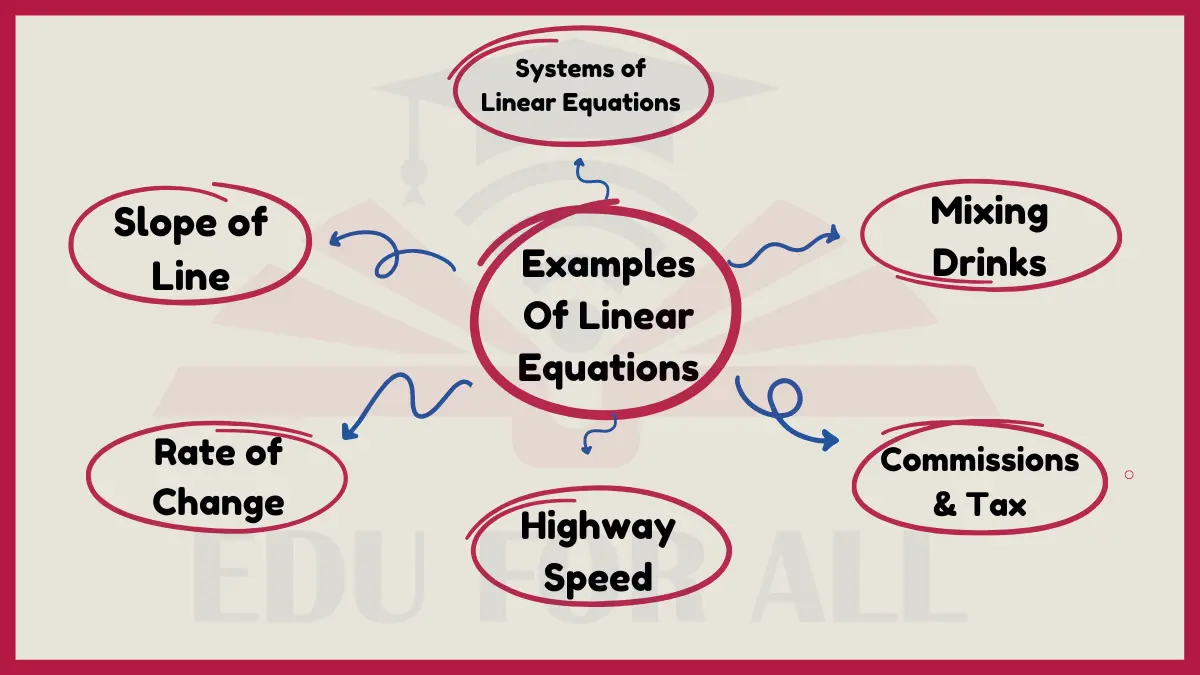Examples of linear equations are abundant in real life situations. We can observe them frequently in various contexts including business, sports, cooking, construction and more. The key defining characteristic of a linear equation is that it describes a straight line relationship between variables.

Examples Of Linear Equations
Here are examples of linear equations:
1: Slope of a Line
The most basic linear equation is that which describes a straight line, typically written as y = mx + b. Here m represents the slope of the line, which quantifies its steepness. The variables x and y have a linear relationship along the line.
Experiment: Graph various lines by plotting points with different slope and y-intercept values to observe the linear pattern.
2: Rate of Change
Looking at how a quantity changes over time often yields a linear equation. For example, velocity which measures displacement over time, and marginal profit which considers profit made per additional unit sold exhibit linear rate of change.
Experiment: Make a hypothetical distance traveled over time data table. Plot the values on a graph and note the constant slope.
3: Systems of Linear Equations
Multiple linear equations with several variables can be solved simultaneously resulting in a single solution point that fits all equations. This commonly occurs in optimization problems that require balancing multiple linear constraints or objectives.
Experiment: Use graph paper to manually solve a 2-variable/2-equation system by finding the intersection point of the lines.
4: Mixing Drinks
Mixing different juices or alcohol to create a final desired flavor or potency is an everyday example. If you mix 2 cups of apple juice and 3 cups of orange juice, the amount of each ingredient and total volume has a linear relationship.
Experiment: Mix water and juice in different ratios and taste how sweetness changes.
5: Highway Speed
The distance traveled on a highway can be modeled by a linear equation if speed is constant. Distance = Rate x Time exemplifies the straight line relationship between the variables.
Experiment: Use a toy car and measure how far it travels at constant speeds over different times.
6: Cell Phone Plans
Some cell phone companies charge a monthly flat rate for unlimited minutes and texts plus an extra cost per GB of data. The total monthly cost forms a linear equation as number of GB goes up.
Experiment: Plot a graph with number of data GB on one axis and made up monthly costs on the other to visualize the linear pattern.
7: Cooking & Baking
Following or modifying a baking recipe requires linear scaling. If a recipe serves 4 people, you can linearly adjust ingredient quantities to serve 6 or 8 people instead through multiplication and addition.
Experiment: Double or triple a cookie recipe and observe how it affects the yield.
8: Commissions & Tax
Sales commissions and taxes create linear relationships between amount sold and earnings. Total pay is the base salary + percentage commission times sales. Taxes show the same linear association between tax rates and amounts owed.
Experiment: Calculate commissions or sales tax for sample purchases at made up rates to examine the linear relationship at work.
9: Tile Flooring
Figuring out how many tile squares it would take to cover a kitchen floor requires linear thinking. If each tile has dimensions 1 foot x 1 foot, the number of tiles equals the total area of the floor space.
Experiment: Use graph paper to sketch out a “room” and pencil in tile squares to visualize covering the area.
Read Examples of Area
10: Plant Growth
Under ideal conditions, plants tend to grow at a linear rate over certain periods of time. The relationship between a plant’s height and time elapsed can be described by a linear equation.
Experiment: Make a plant growth chart by marking its height each day with a ruler and compare early versus later growth patterns.
11: Savings Accounts
The amount of money accrued in a basic savings account tends to increase linearly over time at a constant interest rate, rather than exponentially like stocks.
Experiment: Plug different money amounts, times lengths and interest rates into online compound savings calculators to see the linear effect of regular contributions.
12: Painting a Room
To buy the correct amount of paint for a room, you need to account for the room’s linear dimensions and recommended paint coverage per gallon or liter. Total paint needed scales up linearly with room size.
Experiment: Calculate paint needed for rooms of different made up dimensions using realistic paint coverage numbers.
Also Read

